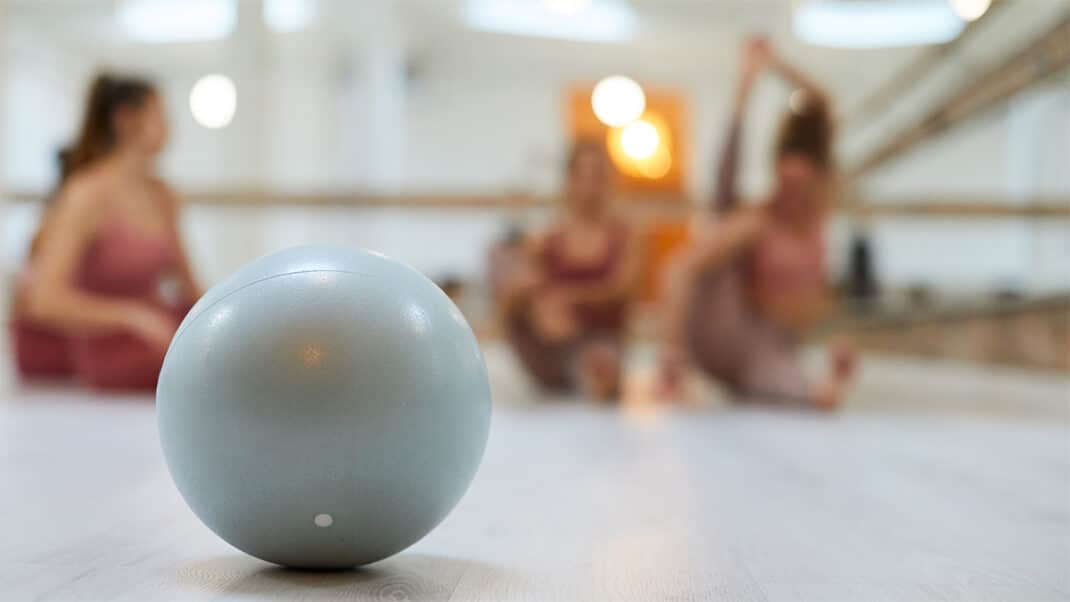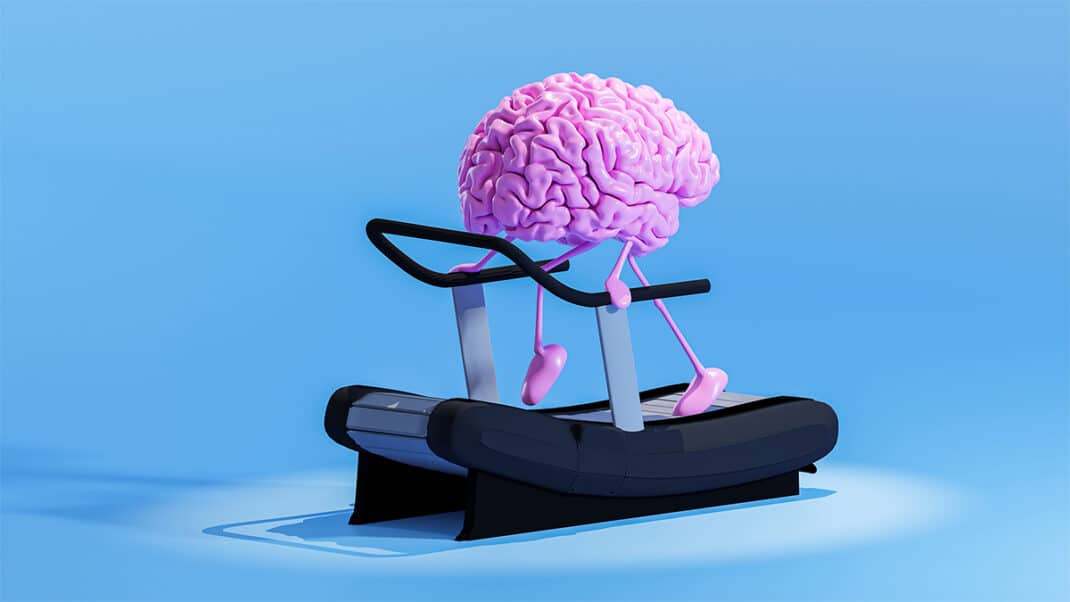Sample Class: Stability Ball Muscle Sculpt
Emphasize muscle endurance and balance.
The stability ball is one of the most widely used training tools in the fitness industry. However, many instructors use it only for a small segment of their classes, such as abdominal training at the end. The following format utilizes the stability ball throughout for total-body muscle sculpting. This class continuously challenges participants with exercises that use either body weight only or dumbbells.
There are numerous benefits to adding the ball to your muscle-sculpting class. The ball lets you offer endless choreography options in addition to built-in balance and stability tests. Also, by making slight changes in body positioning on the ball, you challenge muscles at different points in the range of motion.
Warm-Up
(8–10 Minutes)
Include basic movement patterns that bring awareness to posture and breathing as you acclimate participants to the ball and warm their muscles. Have everyone stand with feet hip width apart in neutral posture, holding the ball in front of the body, slightly below chest level.
- Roll shoulders back, 8x.
- Roll shoulders forward, 8x.
- Inhaling, lift ball overhead (OH), 4 counts.
- Exhaling, hinge at hips and lower ball to floor, 4 counts.
- Inhaling, roll ball in toward feet while rounding spine, 4 counts.
- Exhaling, roll ball out, going back to hip hinge and neutral spine, 4 counts.
Repeat last two steps.
- Inhaling, roll ball in, 4 counts.
- Exhaling, roll up one vertebra at a time, bringing ball with you until standing again, 8 counts.
- March in place, 16 counts.
- Alternate step-out squats (right, left [R, L]); press ball out in opposite direction, 12x. Tip: Keep hips centered, avoid lunging toward knee, engage abdominals and keep spine
neutral.
- Alternate lunges back (R, L); lift ball OH, 12x. Tip: Keep front knee over ankle.
- Alternate step-out squats (R, L) and lunges back (R, L), 12x.
- Stand with feet hip width apart, toes and knees straight ahead, in neutral posture (as in starting position) and squat:
- 1 count down, 1 count up, 8x.
- 1 count down, hold 2 counts, 1 count up, 4x.
- 1 count down, hold 2 counts (add OH lift), 1 count up, 8x. Tip: When adding OH lift, cue for neutral spinal alignment.
- Stand with feet slightly wider than shoulder width apart; lunge side to side, pressing ball to same side at chest level, 8x.
- Continue lunging, move ball to floor and roll it from hand to hand, 8x.
- Hold lunge to R side; with L hand on ball, continue to roll ball farther to R then back toward center, stretching lats, 8x. Repeat on L side.
- Bring ball back to center, pick it up and return to standing position.
Sculpt Segment
(30–35 Minutes)
Perform all exercises as follows unless indicated otherwise:
Lower Body: Lift 2 counts (concentric phase), lower 2 counts (eccentric phase), 8x; 1 count concentric, 1 count eccentric, 16x + 16–32 pulses.
Upper Body: 2 counts concentric, 2 counts eccentric, 8x; 1 count concentric, 1 count eccentric, 8x + pulses optional.
- hip extension (R, L) (From standing position, bend forward, place hands on ball and lengthen leg toward back of room.)
- prone plank push-up (Hard = feet on ball; easy = upper shins on ball.)
- prone over ball (POB) triceps kickback 5 lb (Work both arms at same time; keep shoulders away from ears and elbows slightly above back.)
- seated squat (Seat is barely touching ball; all weight is in quads. Hold 3 counts, sit down on 4; squat 16x, hold 8 counts. Use one hand to “spot” ball.)
- supine incline chest press, 8 lb (Support lower back on ball; hips and knees are at 90-degree angle.)
- supine incline biceps curl, 8 lb
- supine incline trunk curl, 8 lb (Hold weights at chest level.)
- bridge hip flexion/extension, 8 lb (Hold weights on top of hips.)
- supine bridge lat pull-over, 8 lb (Lift 2 counts, lower 2 counts; arms straight, weights pressed together, extend overhead and return to start.)
- supine bridge triceps extension, 5 lb
Tip: On last two exercises, watch for spinal alignment. Don’t allow ribs to lift during extension.
- supine trunk curl (5 lb optional)
- supine incline chest stretch
- supine incline figure-four stretch
- seated lateral lift, 5 lb (Lift arms to sides, stopping at shoulder level.)
- POB double hip extension (Keep legs together and lengthen toward back while engaging glutes.)
- POB lat row, 8 lb (Work both arms simultaneously.)
- POB biceps curl, 8 lb (Anchor elbows on ball.)
- POB anterior deltoid raise, 5 lb (Keep hips slightly behind ball to counterbalance arms extending in front of ball.)
- kneeling lat stretch (Keep hips over knees and roll ball out with hands.)
Focus Segment:
Core (10 Minutes)
- POB opposite arm/leg reach, 8–12x each side
- prone plank hold + 1 leg only (R, L), 30 seconds–2 minutes per side (Engage abs; watch for sagging in lower back or piking in hips.)
- POB trunk extension, 2 counts down, 2 counts up, 12–16x. Tip: Anchor feet on wall if possible.
- lateral flexion, 2 counts down, 2 counts up, 12–16x per side (Lying on side, feet slightly staggered, hip on ball and rib cage off ball, lift torso.)
- v-sit, seated on mat, holding ball in front at chest level, 30 seconds–2 minutes
- v-sit with rotation (R, L), 8–16x per side
- supine (on mat) elevated legs (SEL) bridge hold + 1 leg only (R, L), 30 seconds–2 minutes per side (Extend hips and engage glutes.)
Final Stretch
(5 Minutes)
- SEL butterfly stretch (adductors)
- SEL figure-four stretch (hip external rotators)
- kneeling lat stretch and cat stretch (lats, muscles along the spine)
- standing forward bending pike stretch (hamstrings)
- standing lunge hip flexor/quad stretch
- seated lateral flexor stretch, OH reach (spine)
- supine incline chest stretch (pectorals, anterior deltoids, biceps)
- seated overhead one-arm triceps stretch n
- Size the ball properly for each participant. When seated, hips should be level with or slightly higher than the knees.
- Teach students to move slowly and with control in and out of position on the ball, particularly when holding weights.
- Remind participants to be aware of where equipment is placed on the floor when rolling in and out of position.
- Establish correct body alignment and position on the ball before adding additional movement challenges.
- Remind students to breathe; some tend to hold their breath when stabilizing on the ball.
- Cue slower tempos first, to establish control, before increasing the tempo.
- Continually cue proper alignment and correct technique for a safe learning environment.






